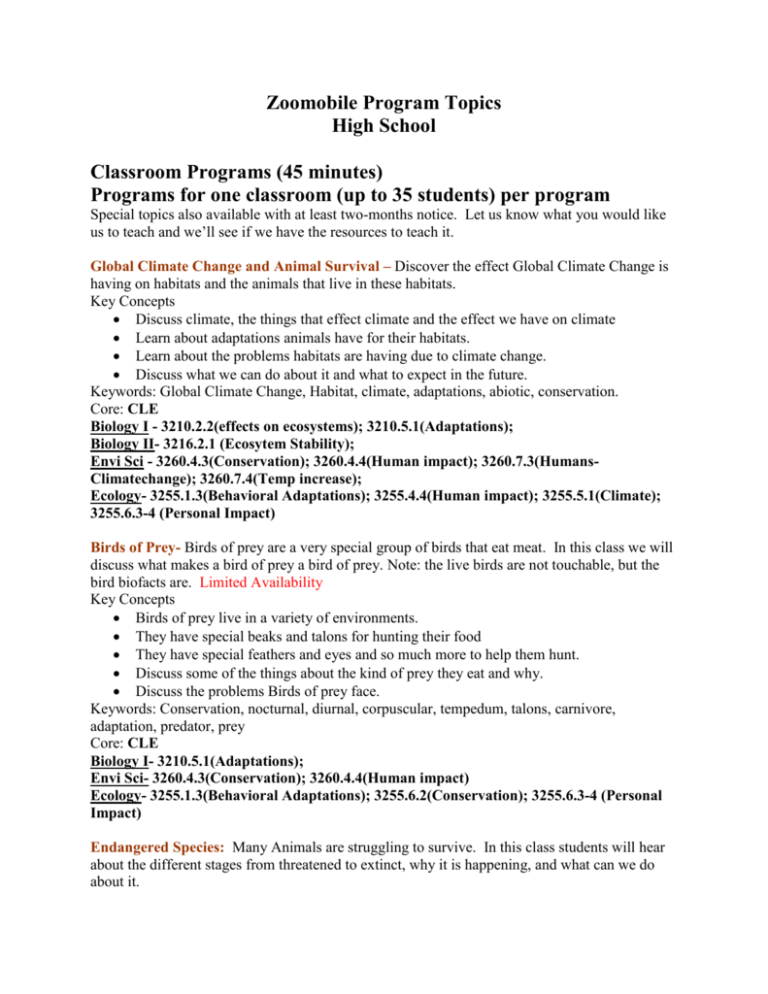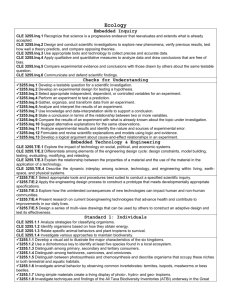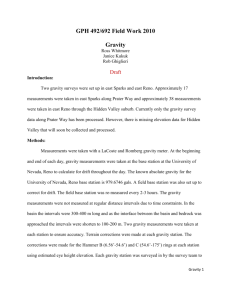Zoomobile Team Topics High School
advertisement

Zoomobile Program Topics High School Classroom Programs (45 minutes) Programs for one classroom (up to 35 students) per program Special topics also available with at least two-months notice. Let us know what you would like us to teach and we’ll see if we have the resources to teach it. Global Climate Change and Animal Survival – Discover the effect Global Climate Change is having on habitats and the animals that live in these habitats. Key Concepts Discuss climate, the things that effect climate and the effect we have on climate Learn about adaptations animals have for their habitats. Learn about the problems habitats are having due to climate change. Discuss what we can do about it and what to expect in the future. Keywords: Global Climate Change, Habitat, climate, adaptations, abiotic, conservation. Core: CLE Biology I - 3210.2.2(effects on ecosystems); 3210.5.1(Adaptations); Biology II- 3216.2.1 (Ecosytem Stability); Envi Sci - 3260.4.3(Conservation); 3260.4.4(Human impact); 3260.7.3(HumansClimatechange); 3260.7.4(Temp increase); Ecology- 3255.1.3(Behavioral Adaptations); 3255.4.4(Human impact); 3255.5.1(Climate); 3255.6.3-4 (Personal Impact) Birds of Prey- Birds of prey are a very special group of birds that eat meat. In this class we will discuss what makes a bird of prey a bird of prey. Note: the live birds are not touchable, but the bird biofacts are. Limited Availability Key Concepts Birds of prey live in a variety of environments. They have special beaks and talons for hunting their food They have special feathers and eyes and so much more to help them hunt. Discuss some of the things about the kind of prey they eat and why. Discuss the problems Birds of prey face. Keywords: Conservation, nocturnal, diurnal, corpuscular, tempedum, talons, carnivore, adaptation, predator, prey Core: CLE Biology I- 3210.5.1(Adaptations); Envi Sci- 3260.4.3(Conservation); 3260.4.4(Human impact) Ecology- 3255.1.3(Behavioral Adaptations); 3255.6.2(Conservation); 3255.6.3-4 (Personal Impact) Endangered Species: Many Animals are struggling to survive. In this class students will hear about the different stages from threatened to extinct, why it is happening, and what can we do about it. Key Concepts Learn about the stage threatened, endangered, critically endangered, extinct in the wild, and extinct. Learn some of the causes of extinction (poaching, deforestation, disease, invasive species, etc) Learn a few ways we can make a difference Keywords: Threatened, endangered, extinct, invasive species, deforestation, poaching, predator, prey, habitat, reduce, reuse, and recycle. Core: CLE Biology I- 3210.2.3(effects on ecosystems); 3210.5.1(Adaptations); Biology II- 3216.2.1(Ecosytem Stability); Envi Sci- 3260.4.3(Conservation); 3260.4.4(Human impact); 3260.7.2(Gov protect bio); 3260.7.3(Humans-Climatechange); 3260.7.4(Temp increase); Ecology- 3255.4.4(Human impact); 3255.6.2(Conservation); 3255.6.3-4 (Personal Impact) Habitats: Biomes to Niches: Examine habitats from a global to local scale, differentiating between habitats, biomes, ecosystems and niches. Key Concepts Habitats are any place where living things can survive. Biomes are types of habitats. Biomes are affected by biotic and abiotic factors Ecosystems are any area where the living things are able to interact with each other. All habitats provide the four basic needs (food, water, protection, air) for animals. Food chains transfer energy and recycle the nutrients in an ecosystem while the sun provides energy. A food web is more descriptive of what is actually happening. Each animal in an ecosystem has a role or niche. Animals must have adaptations to fill their niche. We need the natural resources from habitats to survive, too. How we use them affects habitats, and our ability to survive. Key Words: habitat, biome, ecosystem, niche, producer, primary consumer, secondary consumer, decomposer, food chain, food web, adaptation, energy Core: CLE Biology I - 3210.2.3(effects on ecosystems); 3210.5.1(Adaptations); Biology II - 3216.2.1 (Ecosytem Stability); 3216.2.2(Population); Envi Sci- 3260.2.3(Biomes); 3260.4.3(Conservation); 3260.4.4(Human impact); 3260.7.3(Humans-Climatechange); 3260.7.4(Temp increase); Ecology- 3255.1.3(Behavioral Adaptations); 3255.4.4(Human impact/ecosystem); 3255.5.1 (Climate); 3255.5.2(Terrestrial Biomes); 3255.5.4 (Niches), 3255.5.5 –(Human impact/biome); 3255.6.2(Conservation); 3255.6.3-4 (Personal Impact) Biodiversity and Biogeography: Explore the meaning of biogeography and biodiversity, how geography can affect biodiversity, and how we can affect both. Key Concepts Biogeography is the study of the distribution of living things. Animals live in different places because: o their biomes are found in different places o their adaptations may only allow them to live in certain biomes o geography may prevent them from expanding their range o the size and location of an ecosystem may limit what living things can survive there. Geography can affect biodiversity by limiting expansion and natural resources. Biodiversity is the number of different living things in an area. Biodiversity is important for long-term ecosystem survival. The use of natural resources by humans affects biogeography, which can decrease biodiversity. Humans are dependent on biodiversity for survival. Conservation can prevent biodiversity loss, improving our ability to survive. Key Words: biodiversity, biogeography, adaptations, biomes, ecosystems, natural resources. Core: CLE Biology I- 3210.2.3(effects on ecosystems); 3210.5.1(Adaptations); Biology II- 3216.2.1 (Ecosytem Stability); 3216.2.2(Population); Envi Sci- 3260.2.2(Biodiversity); 3260.2.3(Biomes); 3260.4.3(Conservation); 3260.4.4(Human impact); 3260.7.3(Humans-Climatechange); 3260.7.4(Temp increase); Ecology- 3255.1.4(Biodiversity); 3255.4.4 (Human impact); 3255.4.5 (Biodiversity); 3255.5.2(Terrestrial Biomes); 3255.5.4 (Niches), 3255.6.2(Conservation); 3255.5.5 –(Human impact/biome) Suitcase For Survival - Investigate the illegal wildlife trade, how it affects endangered species, how you may be involved, careers in wildlife conservation and how we can help stop the illegal wildlife trade. Key Concepts Many animals face multiple threats to their survival. People depend on wildlife to survive. Not all wildlife trade is illegal, but some are illegal to hunt, capture or sell because they are endangered. Definition of threatened, endangered, and extinct. Animals are harvested for many reasons, including for food, medicine, souvenirs/jewelry, clothing, private collections and pets. While people have harvested animals for millennia, it is a problem now because of the large volume of animals harvested. Most people who buy illegal products do not realize that they are involved with the illegal wildlife trade. You can help wildlife by being careful about what you buy and teaching others. Keywords: threatened, endangered, extinct, population, trade, wildlife, habitat loss, pollution, climate change, poaching. Core: CLE Biology I- 3210.2.3(effects on ecosystems); Biology II- 3216.2.1 (Ecosytem Stability); 3216.2.2(Population); Envi Sci- 3260.4.3(Conservation); 3260.4.4(Human impact); 3260.7.2(Gov protect bio); 3260.7.3(Humans-Climatechange); 3260.7.4(Temp increase); Ecology- 3255.4.4(Human impact); 3255.6.2(Conservation); 3255.6.3-4 (Personal Impact) Ornithology and Avian Conservation – Learn about some of the different groupings of birds, as well as some of their evolutionary history. Learn how well-adapted bird species struggle to keep pace with local and global changes to their habitats and other human pressures, how their loss can affect us and how we can help. Note: the live birds are not touchable, but the bird biofacts are. Limited Availability Key Concepts There are many different classes of birds All birds have adaptations for surviving in their habitat. Habitats are changing locally and globally, mostly through human activity. Changes to a habitat can require new adaptations to survive. If changes happen too fast, birds may not be able to adapt quickly enough. Poaching and invasive species also lead birds to become threatened, endangered or extinct. Birds are ecologically important as pollinators, seed dispersers, predators and prey. Birds are economically important, providing free pest control, fertilization, food and recreational opportunities (fastest growing recreational pursuit in the world). Birds are important aesthetically. Humans will be negatively affected in many ways as bird species are lost. Resource conservation, wildlife careers, and educating others can help decrease bird losses. Keywords: adaptation, Ornithology, endangered, threatened, extinct, habitat, poaching, invasive species, ecology, economy, conservation, career, climate change. Core: CLE Biology I- 3210.2.3(effects on ecosystems); 3210.5.1(Adaptations); Biology II- 3216.2.1(Ecosystem Stability); 3216.2.2(Population); Envi Sci- 3260.4.3(Conservation); 3260.4.4(Human impact); 3260.7.3(Humans-Climate change); 3260.7.4(Temp increase); Ecology- 3255.4.4(Human impact); 3255.6.2(Conservation); 3255.6.3-4 (Personal Impact) Herpetology Conservation – Learn about some of the different groupings of reptiles and amphibians, as well as some of their evolutionary history. Learn how well-adapted reptile and amphibian species struggle to keep pace with local and global changes to their habitats and other human pressures, how their loss can affect us and how we can help. Note: the live amphibians are not touchable, but the reptiles and biofacts are. Key Concepts There are many different classes of reptiles and amphibians All reptiles and amphibians have adaptations for surviving in their habitat. Habitats are changing locally and globally, mostly through human activity. Changes to a habitat can require new adaptations to survive. If changes happen too fast, reptiles and especially amphibians may not be able to adapt quickly enough. Invasive species also lead reptiles and amphibians to become threatened, endangered or extinct. Reptiles and Amphibians are ecologically important as predators and prey species in the Food Chain. Reptiles and Amphibians are economically important, providing free pest control, fertilization, food and medicinal uses. Reptiles and amphibians are important aesthetically. Humans will be negatively affected in many ways as reptile and amphibian species are lost. Resource conservation, wildlife careers, and educating others can help decrease reptile and amphibian losses. Keywords: adaptation, Herpetology, endangered, threatened, extinct, habitat, poaching, invasive species, ecology, economy, conservation, career, climate change. Core: CLE Biology I- 3210.2.3(effects on ecosystems); 3210.5.1(Adaptations); Biology II- 3216.2.1(Ecosystem Stability); 3216.2.2(Population); Envi Sci- 3260.4.3(Conservation); 3260.4.4(Human impact); 3260.7.3(Humans-Climate change); 3260.7.4(Temp increase); Ecology- 3255.4.4(Human impact); 3255.6.2(Conservation); 3255.6.3-4 (Personal Impact) What Do You Zoo? - Examine the role of zoos in wildlife conservation, wildlife and zoo careers, and what you can do to help. Key Concepts Zoos exist for many reasons, mainly for conservation of wildlife. Strategies for conservation include captive breeding of endangered species, behavioral and reproductive research, wildlife rehabilitation, and educating the public. Zoo’s cooperate with each other for greater success, through programs such as Species Survival Plans. You can help zoos conserve wildlife through volunteering, a wildlife career, or simply conserving resources. Keywords: conservation, endangered, threatened, extinct, captive breeding, research, species survival plan, wildlife, career. Core: CLE Biology I- 3210.2.3(effects on ecosystems); Envi Sci -3260.4.3(Conservation); 3260.4.4(Human impact); Ecology-3255.4.4(Human impact); 3255.6.2(Conservation); 3255.6.3-4 (Personal Impact) Animal Art and Photography - Live animal models can bring your art or photography class to life. Each model’s adaptations and habitat will be described briefly while the model poses. The program may include free-flight demonstrations with birds, upon request, but must be in a room with doors that close. Note: the live birds are not touchable and have limited availability Option 1: One model at a time will be presented for approximately 10-15 minutes each. Option 2: Multiple models (birds only) can be presented at the same time for longer periods.










